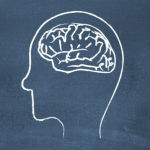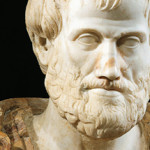Why Humans Are More Than Mere Animals
by Dr. Dennis Bonnette
Filed under Man, Philosophy, Uncategorized

Ever since the time of Charles Darwin’s thunderous appearance on the human stage, evolutionary materialists have envisioned a world in which man appears without any rational need either for the God of classical theism or for a spiritual and immortal human soul. Human beings are finally to be classed as merely highly-developed subhuman hominins, whose mental abilities do not differ in kind from those of other primates. Human intellectual activity is thought to be merely a highly-evolved form of sentient activity, which, in turn, is ultimately reducible to highly-evolved neural patterns and activity within an advanced primate brain.
Still, a curious hangover from earlier Platonic times has haunted this view of the world, something philosophers have long wrestled with, known as the “problem of universals.”
The Problem of Universals
Today many philosophers debate the exact status of universals. While it is clear that a universal term is one thing predicated of many, this linguistic reality gives rise to important and controversial philosophical questions. Do universals exist only in speech or are they something that exists independently in the real world? If they exist in the mind, what do they ontologically constitute within the human person – merely some biological phenomenon, or a spiritual product evincing human spiritual immortality? Or, do they exist independently of the mind? If so, are they merely something really common found within things? Or, do they actually exist in a world of their own, independent of both men’s minds and natural objects – as Plato claims?
Down through the long history of Western philosophy, major and minor thinkers have sought to give answers to these sorts of questions. Proper evaluation of these many positions would properly require a lengthy professional journal article or even a book – far beyond the scope of this present short piece.
Instead, what I propose to do here is to examine the actual cognitive objects involved in this extensive discussion, not with a view to declaring a winner in the debates between the various positions, but simply to show that the basis for the debates entail two distinct cognitive entities which are clearly incommensurable with each other, namely, the image and the concept.
Image and Concept
One might wonder why I am now talking about the concept (also called an “idea”) rather than the universal. It is because we encounter the universal first in the form of the universal concept, which is the intellectual representation of something that is common to many and can, therefore, be predicated of many individuals. Hence, I will be talking about the concept, or universal concept, as the cognitive object in and through which the universal is understood. Thomistic philosophers maintain that the universal concept is a spiritual in nature. Since the human intellect produces this spiritual concept, they then use this fact to argue for the spirituality and immortality of the human soul.
The image is viewed generally as an internal sense representation, such as one has when he closes his eyes and imagines a “picture of a cow.” More technically, for Thomistic philosophers, an image is any sense impression of one of the internal senses, especially the imagination or sense memory.
For many, the distinction between a concept and an image is not clear, leading to such common depictions as that of forming a picture of a “blindfolded lady holding scales” in one’s “mind,” when having an idea of justice.
The Scottish skeptic, David Hume, who has greatly influenced the thinking of many modern materialists, was guilty of such confusion. Hume distinguishes between “impressions,” which he views as vivid and lively perceptions, and “ideas,” which are products of imagination and memory, making them less vivid and lively. But both “impressions” and “ideas” remain experiences, with ideas being merely weak resemblances of direct experience. One might rightly think that Hume has primarily in mind sense experience, when he speaks of “impressions.” Still, he also includes such things as love, hate, and acts of will.
Indeed, it is quite predictable that modern evolutionary materialists would find themselves unable to think of ideas or concepts as anything other than the same kind of neural activity that they conceive sensation to entail. Suggesting that intellectual knowledge could be radically different in kind from sense knowledge might be the belief of medieval theologians and philosophers, but such byproducts of assumed metaphysical dualism appear to have no place in modern science and its philosophical interpretations, according to these scientific materialists.
The Differences
For evidence of the radical differences between images and concepts (ideas), I shall turn to the work of Fr. Austin M. Woodbury, S.M., who taught philosophy for decades at the Aquinas Academy in Sydney, Australia, which he founded following World War II. Woodbury, who studied under Fr. Reginald Garrigou-Lagrange, distinguished himself by thoroughly systematizing the work of St. Thomas Aquinas in a manner not found in the writings of Garrigou-Lagrange or other contemporary Thomists.
Woodbury enunciates many clear differences between images and concepts, thereby underlining the radical epistemological and ontological distinction between them. The following seventeen distinctions are based on his work.1
1. An image is solely of how something appears to the senses, as having this color or that shape or sound. But, the concept gives us the very nature of something, for example, a mammal is understood as an animal that gives milk.
2. An image always exhibits singular sensible qualities, for example, a particular color or shape or loudness or smell. But, a concept may have no sensible qualities, for example, justice, truth, or goodness. Even a sensible quality, considered as universal, may have no sensible qualities, for example, color, as such, is colorless and loudness, as such, is silent.
3. An image is always singular, for example, this pig or this car. But, the concept is always universal (unum-versus-alia: one against others), an understanding that applies to many things, for example, triangularity or mankind.
4. An image has no degrees of extension, that is, that is, the number of individual things to which it applies. For example, the image of this horse applies to this horse only. But, a concept has degrees of extension. Horse, as such, applies to all horses; animal applies to all animals. Yet, animal has greater extension than horse, since it applies to all animals, including all horses.
5. An image can be produced extramentally, as say, a statue or painting of a given height, color, and so forth. But the concept cannot be produced extramentally, since there is no single statue or painting that can physically be all horses at once. How does one make a painting or statue of “living?” That is why abstract art looks so bizarre! You can make a statue of Lincoln, but you cannot make a statue of humanity, since you cannot express all mankind at once physically in a single statue.
6. An image makes no distinction within itself. For example, an image of horse does not distinguish its vegetative powers from its sentient powers. But we can abstract its vegetative powers from its sentient powers and consider the conceptual distinction between them.
7. An image is always concrete. It is this triangle on this board at this time, with its exact shape, color, and size. The concept is abstract. It abstracts from all the singularizing aspects of the image. The concept of animal abstracts from the concrete accidental qualities of the zebra image that may be associated with it.
8. Images constitute the fleeting, changing sense content that accompanies conceptual knowledge, which is stable. Writing a paper on animals may evoke many associated images of various individual cows, horses, stables, hunters, and so forth – constituting a disconnected kaleidoscope of sensible images connected only by the underlying conceptual theme.
9. Images follow the laws of association of images, as in sailors and ships, whereas concepts follow the laws of reason, as hammering is understood as a cause with a loud noise being its effect.
10. Images can vary without changing one’s logical train of thought, whereas changing concepts under consideration can destroy the logic of thought. Thus, imagining horses, chickens, or mice does not affect thinking about animals, but shifting from animals to plants would distract from thinking solely about animals.
11. Image clarity does not assure clear thinking, but clear thinking – even with confused images – can still lead to true understanding. Conversely, conceptual confusion will lead to false conclusions no matter how vividly and clearly it is associated with images.
12. Despite variations in images, concepts may remain stable. Thus, whether one imagines squirrels, bats, or mice, the concept of animal is unaffected. Also, verbal images may vary while conceptual content is untouched. For example, homme, Mann, uomo, homo, and hombre all signify “man,” despite the varied verbal image.
13. Images alone do not permit speech to take place. Speech is based on concepts, not images. The same word, animal, may evoke an image of a horse to one person but a mongoose to another person. If the word stood for the image, its content would be equivocal! That is why one does not say, “Did you get my images?,” but rather, “Did you get my meaning, that is, the conceptual content intended?”
14. If we thought only in images, translation from one language to another would be impossible. The image does not convey a single, defined meaning. The image of a man does not reveal whether it stands for an adult, a male, Homo sapiens, intelligence, a criminal, or any of a number of other significations. Words themselves are purely arbitrary, meaning nothing unless you already know their meaning or assign them a new meaning.
15. The judgment establishes a relation of affirmation or negation between a subject and a predicate. Such a relation is not an image.
16. Reasoning entails apprehension of a nexus between premises and a conclusion. This nexus is not an image.
17. While an image represents an individual entity existing in space, the concept represents the nature outside of a given space and time.
Woodbury defines a “common image” as an image of a singular thing according to sensible appearances that happens to be similar to other singular things.2 While useful for the instinctive life of, say, a mouse, enable it to avoid all cats, it is not to be confused with the intellectual understanding of the nature of a cat, which belongs to the radically distinct universal concept.
Implications of This Radical Distinction
While philosophers may still argue about the exact epistemological and ontological status of the universal concept, what should now be clear is that its nature must be radically distinct from that of the image.
Those philosophers and scientists who reduce all human knowledge to sensation have constantly confused the image with the concept – believing that all thought must be understood merely in terms of images and their associations. In turn, images, for materialists, are grounded in neural patterns or activity – so that concepts, ultimately, were presumed to be basically reducible to just forms of neural activity in the brain. And, since images were thought to be common to man and beast alike, no essential differences between humans and other animals could be based on human intellectual abilities.
But, once it is clear that conceptual knowledge is radically distinct from sense images, the possibility, that human intellectual knowledge is essentially distinct from, and superior to, mere animal manipulation of images, again emerges. The old arguments of ancient philosophers for the qualitative differences between human beings and lower animals become more rationally acceptable. Whatever credence may be given to such arguments, the seventeen distinctions between the image and concept listed above make it clear that it is no longer reasonable for naturalists to claim that universal concepts are merely sophisticated or common images somehow constituted of neural activity in the brain.
Conclusion
Because it is grounded in the individuating, quantifying nature of matter, the image always presents itself under the conditions of matter by being imaginable, concrete, sensible, singular, and particular. For this reason, Thomistic philosophers maintain that images manifest dependence on the physical organs of sensation. There is no indication that the sensory powers which we share with the rest of the animal kingdom make us any more than merely material beings.
On the other hand, the universal concept shows none of the characteristics proper to material beings. It is not imaginable, concrete, sensible, singular, or particular. In a word, the concept appears to be not material in nature and, entirely unlike the image, shows no signs of being dependent on matter. Concepts appear to be spiritual in nature. From the fact that human beings – alone in the animal kingdom – have the intellectual ability to form such universal concepts, Thomistic philosophers propose arguments demonstrating the spirituality and immortality of the human soul.3
Perhaps, humans are, after all, God’s special creatures, superior in nature to all lower forms of physical creation, including other animals. Perhaps, men are placed on earth – not as coequal species to other living things – but as stewards responsible for overseeing the welfare of all subhuman creation within their power, including lower animals.
While irrational animals may possess sensitive, but mortal, souls, they do not possess spiritual and immortal souls. Such spiritual souls would have to have been endowed by our Creator solely to genuine human beings, whose essential superiority is marked by our remarkable species’ unique ability to think in terms of universal concepts – an ability totally absent in the rest of this planet’s sentient organisms.4
Related Posts
Notes:
- Austin M. Woodbury, Natural Philosophy, Treatise Three, Psychology, Bk. 3, Ch. 40, Art. 7 (Sydney: Aquinas Academy, unpublished manuscript, 1951), pp. 432-65. Woodbury’s “unpublished manuscripts” included thousands of pages of high quality academic volumes divided according to the various philosophical sciences, including natural philosophy, psychology, metaphysics, and epistemology. They were used by many thousands of students at the Aquinas Academy over several decades. While not formally published, their contents were of peer reviewed quality and acknowledged as such by other distinguished scholars. I wish also to acknowledge the contribution of my late friend and long-time colleague at Niagara University, philosopher Raphael T. Waters, D.Ph., who was an associate of Fr. Woodbury at the Aquinas Academy and who promulgated Woodbury’s philosophical achievements to students and other academics in North America. Dr. Waters published extensively on such ethical topics as capital punishment and the principle of double effect. ↩
- Woodbury, Natural Philosophy, p. 433. ↩
- Benignus Gerrity, Nature, Knowledge, and God (Bruce Publishing Company, 1947), 193-210. ↩
- Dennis Bonnette, Origin of the Human Species (Sapientia Press, 2014), 103-110. ↩
Note: Our goal is to cultivate serious and respectful dialogue. While it's OK to disagree—even encouraged!—any snarky, offensive, or off-topic comments will be deleted. Before commenting please read the Commenting Rules and Tips. If you're having trouble commenting, read the Commenting Instructions.












